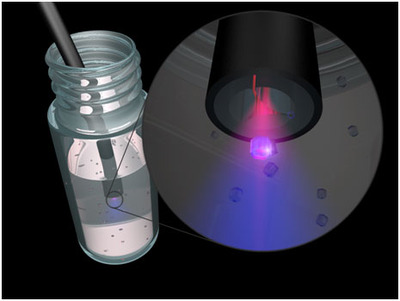Optical fibres enable a bright future for nanocrystal measurement
A team of researchers from Macquarie University, the University of Adelaide and Peking University has discovered a way to measure the world’s most sensitive nanoparticle from a distance using light. The research has been published in the journal Nature Nanotechnology.
Sensing at the single molecular level has previously been limited by insufficient signal strength and interference from background noise. The new approach brings together an upconversion nanocrystal or ‘SuperDot’ - superbright, photostable and background free - with a special kind of optical fibre that enables light to interact with nanoscale volumes of liquid. The nanoparticles take longer wavelengths of light and turn them into light at shorter wavelengths.

The University of Adelaide’s Dr Erik Schartner explained that the particles “have been synthesised so that they’re much more efficient at generating light than the conventional particles that have been used in the past” - thus when hit with a lot of light, the SuperDots in turn strongly emit their own. Under infrared illumination, the particles selectively produce bright blue, red and infrared light, with 1000 times more sensitivity than existing materials.
“Neither the glass of the optical fibre nor other background biological molecules respond to infrared, so that removed the background signal issue,” explained Dr Dayong Jin, an ARC Fellow at Macquarie University’s Advanced Cytometry Laboratories. “By exciting these SuperDots, we were able to lower the detection limit to the ultimate level - a single nanoparticle.”
Measuring a single nanoparticle used to require placing it “inside a very bulky and expensive microscope”, said Professor Tanya Monro, an ARC Australian Laureate Fellow and director of the University of Adelaide’s Institute for Photonics and Advanced Sensing (IPAS), where the optical fibre was engineered. “For the first time, we’ve been able to detect a single nanoparticle at one end of an optical fibre from the other end.”
The optical fibres allow researchers to reach locations which are inaccessible to conventional measurement tools: “inside the living human brain, next to a developing embryo or within an artery”, said Professor Monro. She said the ability to make measurements from a distance “could ultimately be used within the brain as a way of measuring and understanding the origin of sensation”.
Another example, said Professor Monro, involves “measuring a cell’s reaction in real time to a cancer drug [meaning] doctors could tell at the time treatment is being delivered whether or not a person is responding to the therapy”. Dr Jin noted that Macquarie’s industry partners, Minomic International and Patrys, are currently “developing uses for SuperDots in cancer diagnostic kits, detecting incredibly low numbers of biomarkers within conditions like prostate and multiple myeloma cancer”.
Dr Jin said the optical fibres have also proved useful in understanding the properties of nanoparticles.
Ultracold lab fridge modified for faster, more efficient cooling
By modifying a refrigerator commonly used in both research and industry, researchers have reduced...
Smartphone motion sensors used to detect heart failure
There is a non-invasive technique called gyrocardiography for measuring cardiac vibrations on the...
Fluorescent sensors 'light up' misfolded proteins in the brain
Researchers focused on developing a versatile fluorescent sensor array for amyloids to monitor...







